3-Chloro-4-hydroxyphenylacetic acid

3-Chloro-4-hydroxyphenylacetic acid structure
|
Common Name | 3-Chloro-4-hydroxyphenylacetic acid | ||
|---|---|---|---|---|
| CAS Number | 33697-81-3 | Molecular Weight | 186.592 | |
| Density | 1.5±0.1 g/cm3 | Boiling Point | 348.6±27.0 °C at 760 mmHg | |
| Molecular Formula | C8H7ClO3 | Melting Point | 108-110 °C(lit.) | |
| MSDS | Chinese USA | Flash Point | 164.6±23.7 °C | |
| Symbol |

GHS07 |
Signal Word | Warning | |
| Name | (3-chloro-4-hydroxyphenyl)acetic acid |
|---|---|
| Synonym | More Synonyms |
| Density | 1.5±0.1 g/cm3 |
|---|---|
| Boiling Point | 348.6±27.0 °C at 760 mmHg |
| Melting Point | 108-110 °C(lit.) |
| Molecular Formula | C8H7ClO3 |
| Molecular Weight | 186.592 |
| Flash Point | 164.6±23.7 °C |
| Exact Mass | 186.008377 |
| PSA | 57.53000 |
| LogP | 1.33 |
| Vapour Pressure | 0.0±0.8 mmHg at 25°C |
| Index of Refraction | 1.610 |
| InChIKey | IYTUKSIOQKTZEG-UHFFFAOYSA-N |
| SMILES | O=C(O)Cc1ccc(O)c(Cl)c1 |
CHEMICAL IDENTIFICATION
HEALTH HAZARD DATAACUTE TOXICITY DATA
|
| Symbol |

GHS07 |
|---|---|
| Signal Word | Warning |
| Hazard Statements | H315-H319-H335 |
| Precautionary Statements | P261-P305 + P351 + P338 |
| Personal Protective Equipment | dust mask type N95 (US);Eyeshields;Gloves |
| Hazard Codes | Xi: Irritant; |
| Risk Phrases | R36/37/38 |
| Safety Phrases | S26-S37/39 |
| RIDADR | NONH for all modes of transport |
| WGK Germany | 2 |
| RTECS | CY1576300 |
| HS Code | 2918290000 |
|
~69% 
3-Chloro-4-hydr... CAS#:33697-81-3 |
| Literature: D'Ambrosio; Guerriero; Pietra Helvetica Chimica Acta, 1984 , vol. 67, # 6 p. 1484 - 1492 |
|
~% 
3-Chloro-4-hydr... CAS#:33697-81-3 |
| Literature: Chemische Berichte, , vol. 75, p. 123,129 |
|
~% 
3-Chloro-4-hydr... CAS#:33697-81-3 |
| Literature: Molecular Crystals and Liquid Crystals Science and Technology, Section A: Molecular Crystals and Liquid Crystals, , vol. 237, p. 399 - 406 |
|
~% 
3-Chloro-4-hydr... CAS#:33697-81-3 |
| Literature: Molecular Crystals and Liquid Crystals Science and Technology, Section A: Molecular Crystals and Liquid Crystals, , vol. 237, p. 399 - 406 |
|
~% 
3-Chloro-4-hydr... CAS#:33697-81-3 |
| Literature: Chemische Berichte, , vol. 75, p. 123,129 |
| Precursor 5 | |
|---|---|
| DownStream 4 | |
| HS Code | 2918290000 |
|---|---|
| Summary | HS: 2918290000 other carboxylic acids with phenol function but without other oxygen function, their anhydrides, halides, peroxides, peroxyacids and their derivatives Tax rebate rate:9.0% Supervision conditions:AB(certificate of inspection for goods inward,certificate of inspection for goods outward) VAT:17.0% MFN tariff:6.5% General tariff:30.0% |
|
CprK crystal structures reveal mechanism for transcriptional control of halorespiration.
J. Biol. Chem. 281(38) , 28318-25, (2006) Halorespiration is a bacterial respiratory process in which haloorganic compounds act as terminal electron acceptors. This process is controlled at transcriptional level by CprK, a member of the ubiqu... |
|
|
Degradation of 4-chlorophenylacetic acid by a Pseudomonas species.
J. Bacteriol. 146(1) , 64-8, (1981) Pseudomonas sp. strain CBS3 was able to utilize 4-chlorophenylacetic acid as the sole source of carbon and energy. When this strain was grown with 4-chlorophenylacetic acid, homoprotocatechuic acid wa... |
|
|
[Microbial degradation and 4-chlorophenylacetic acid. Chemical synthesis of 3-chloro-4-hydroxy-, 4-chloro-3-hydroxy- and 4-chloro-2-hydroxyphenylacetic acid (author's transl)].
Hoppe. Seylers. Z. Physiol. Chem. 363(4) , 431-7, (1982) Pseudomonas spec. CBS 3 converts 4-chlorophenylacetic acid partly into 3-chloro-4-hydroxy-, 4-chloro-3-hydroxy-, and 4-chloro-2-hydroxyphenylacetic acid by the action of monooxygenases. However, these... |
| EINECS 251-643-0 |
| 3-chloro-4-hydroxybenzeneacetic acid |
| 3-Chloro-4-hydroxyphenylacetic acid |
| 4-Hydroxy-3-chlorophenylacetic acid |
| (3-Chloro-4-hydroxyphenyl)acetic acid |
| MFCD00004349 |
| Benzeneacetic acid, 3-chloro-4-hydroxy- |
| m-Chloro-p-hydroxyphenylacetic acid |
| 2-(3-Chloro-4-hydroxyphenyl)acetic acid |
| VUFB9649 |
| 4-Hcpa |
| (3-Chlor-4-hydroxy-phenyl)-essigsaeure |
| Benzeneacetic acid,3-chloro-4-hydroxy |
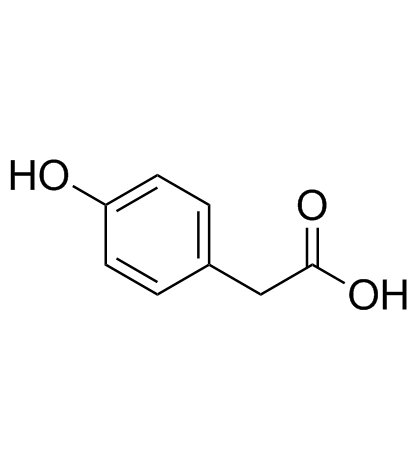
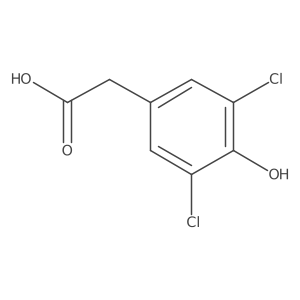

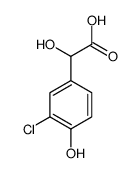


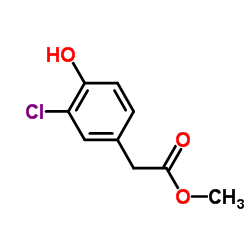 CAS#:57017-95-5
CAS#:57017-95-5![4-Isoxazolecarboxylic acid,3-[2-chloro-4-(2-methoxy-2-oxoethyl)phenyl]-5-methyl- structure](https://image.chemsrc.com/caspic/239/870194-63-1.png) CAS#:870194-63-1
CAS#:870194-63-1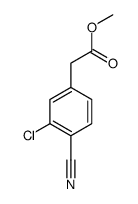 CAS#:496856-45-2
CAS#:496856-45-2
